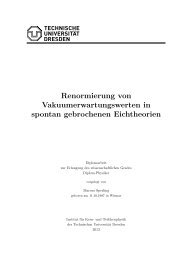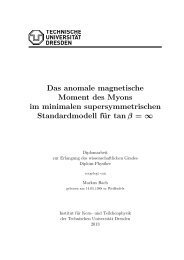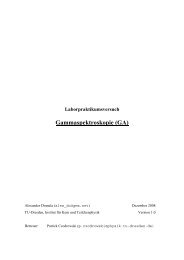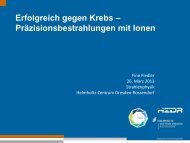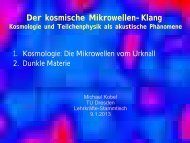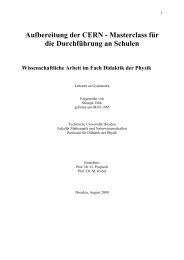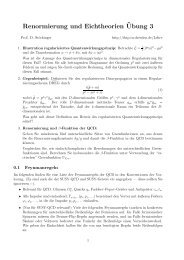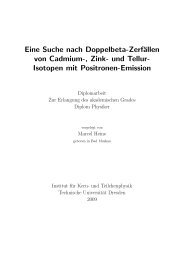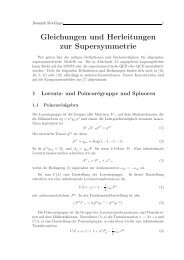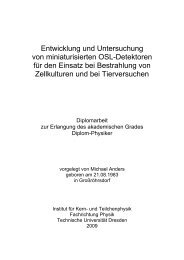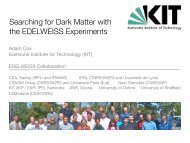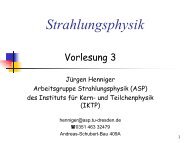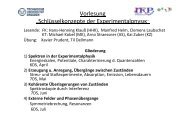a design study for a cobra upgrade to - Institut für Kern- und ...
a design study for a cobra upgrade to - Institut für Kern- und ...
a design study for a cobra upgrade to - Institut für Kern- und ...
You also want an ePaper? Increase the reach of your titles
YUMPU automatically turns print PDFs into web optimized ePapers that Google loves.
14 3 The COBRA experiment<br />
1420:480:340:13:1 [18].<br />
In contrast <strong>to</strong> the other secondary cosmic rays, muons cannot be<br />
s<strong>to</strong>pped by a few meters of shielding material. The muon flux can<br />
only be reduced by going deep <strong>und</strong>ergro<strong>und</strong>, where it is <strong>for</strong> instance<br />
reduced by 4 orders of magnitude in the 3500 meters of water<br />
equivalent (mwe) deep LNGS. There the atmospheric muons<br />
with energies of about 10 GeV up <strong>to</strong> a few TeV can interact either<br />
directly with the detec<strong>to</strong>r material or can produce tertiary neutrons<br />
near the detec<strong>to</strong>r. Their contribution <strong>to</strong> the backgro<strong>und</strong> rate<br />
can be further reduced with an active muon ve<strong>to</strong>. A more serious<br />
impact on low-level experiments have cosmogenic iso<strong>to</strong>pes.<br />
These can be produced in materials, which are exposed <strong>to</strong> cosmic<br />
radiation. (n, γ) interactions or spallation processes with the constituent<br />
iso<strong>to</strong>pes can produce various radionuclides. Radionuclides<br />
with half lives of month or years, being still present in the<br />
components, long after these have been installed <strong>und</strong>ergro<strong>und</strong>,<br />
can be a major problem.<br />
Primordial radioiso<strong>to</strong>pes are iso<strong>to</strong>pes with half-lives of more than 10 9<br />
years, being produced be<strong>for</strong>e the <strong>for</strong>mation of the earth. Iso<strong>to</strong>pes<br />
from the 238 U, 235 U and 232 Th decay chains and 40 K are<br />
most likely <strong>to</strong> find. They are in the labora<strong>to</strong>ry surro<strong>und</strong>ing rock<br />
and in smaller or larger concentrations in all detec<strong>to</strong>r components.<br />
This requires shielding of the detec<strong>to</strong>r from the surro<strong>und</strong>ing<br />
backgro<strong>und</strong> decays, where primary the produced neutrons<br />
and gamma rays must be shielded. Also, a thoughtful selection of<br />
the detec<strong>to</strong>r and shielding material and a subsequent careful handling<br />
of these, in order <strong>to</strong> prevent a subsequent contamination of<br />
the surfaces, is necessary. With the highest prominent gamma line<br />
of 2.614 keV from the 232 Th decay chain, these backgro<strong>und</strong> components<br />
are beyond the most interesting Q-values of double beta<br />
decays, but can disturb the experiments nevertheless. The noble<br />
gas 222 Rn is part of the 238 U decay chain and can leak out of the<br />
surro<strong>und</strong>ing rock, can accumulate in the labora<strong>to</strong>ry air and can<br />
diffuse in<strong>to</strong> the experimental set-up. It decays <strong>und</strong>er the emission<br />
of a 5.5 MeV alpha particle and is there<strong>for</strong>e a problem <strong>for</strong> double<br />
beta decay experiments. Additionally, its decay products are also<br />
radioactive, can attach themselves <strong>to</strong> surfaces near the detec<strong>to</strong>r<br />
and can increase the backgro<strong>und</strong> level further on [18].<br />
Anthropogenic radioiso<strong>to</strong>pes are mainly fallout from nuclear<br />
weapons testing and nuclear accidents, although they can<br />
also exist naturally in lower concentrations. Materials, being<br />
produced be<strong>for</strong>e nuclear weapons testing and especially the



